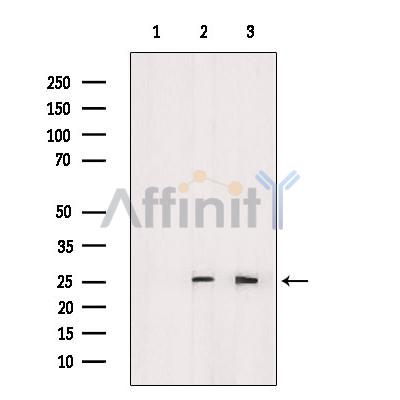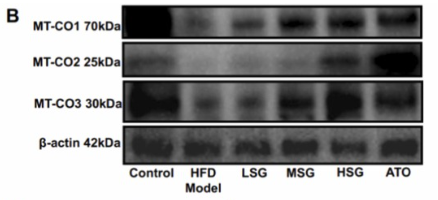Cytochrome c Oxidase 2 Antibody - #DF7867
| Product: | Cytochrome c Oxidase 2 Antibody |
| Catalog: | DF7867 |
| Description: | Rabbit polyclonal antibody to Cytochrome c Oxidase 2 |
| Application: | WB IHC IF/ICC |
| Cited expt.: | WB |
| Reactivity: | Human, Mouse, Monkey |
| Prediction: | Pig, Bovine, Horse, Sheep, Rabbit, Dog, Chicken, Xenopus |
| Mol.Wt.: | 25 kDa, 20 kDa; 26kD(Calculated). |
| Uniprot: | P00403 |
| RRID: | AB_2841296 |
Related Downloads
Protocols
Product Info
*The optimal dilutions should be determined by the end user. For optimal experimental results, antibody reuse is not recommended.
*Tips:
WB: For western blot detection of denatured protein samples. IHC: For immunohistochemical detection of paraffin sections (IHC-p) or frozen sections (IHC-f) of tissue samples. IF/ICC: For immunofluorescence detection of cell samples. ELISA(peptide): For ELISA detection of antigenic peptide.
Cite Format: Affinity Biosciences Cat# DF7867, RRID:AB_2841296.
Fold/Unfold
COII; COX2; COX2_HUMAN; COXII; Cytochrome c oxidase II; Cytochrome c oxidase polypeptide II; Cytochrome c oxidase subunit 2; MT CO2; MT-CO2; MTCO2;
Immunogens
A synthesized peptide derived from human Cytochrome c Oxidase 2, corresponding to a region within the internal amino acids.
- P00403 COX2_HUMAN:
- Protein BLAST With
- NCBI/
- ExPASy/
- Uniprot
MAHAAQVGLQDATSPIMEELITFHDHALMIIFLICFLVLYALFLTLTTKLTNTNISDAQEMETVWTILPAIILVLIALPSLRILYMTDEVNDPSLTIKSIGHQWYWTYEYTDYGGLIFNSYMLPPLFLEPGDLRLLDVDNRVVLPIEAPIRMMITSQDVLHSWAVPTLGLKTDAIPGRLNQTTFTATRPGVYYGQCSEICGANHSFMPIVLELIPLKIFEMGPVFTL
Predictions
Score>80(red) has high confidence and is suggested to be used for WB detection. *The prediction model is mainly based on the alignment of immunogen sequences, the results are for reference only, not as the basis of quality assurance.
High(score>80) Medium(80>score>50) Low(score<50) No confidence
Research Backgrounds
Component of the cytochrome c oxidase, the last enzyme in the mitochondrial electron transport chain which drives oxidative phosphorylation. The respiratory chain contains 3 multisubunit complexes succinate dehydrogenase (complex II, CII), ubiquinol-cytochrome c oxidoreductase (cytochrome b-c1 complex, complex III, CIII) and cytochrome c oxidase (complex IV, CIV), that cooperate to transfer electrons derived from NADH and succinate to molecular oxygen, creating an electrochemical gradient over the inner membrane that drives transmembrane transport and the ATP synthase. Cytochrome c oxidase is the component of the respiratory chain that catalyzes the reduction of oxygen to water. Electrons originating from reduced cytochrome c in the intermembrane space (IMS) are transferred via the dinuclear copper A center (CU(A)) of subunit 2 and heme A of subunit 1 to the active site in subunit 1, a binuclear center (BNC) formed by heme A3 and copper B (CU(B)). The BNC reduces molecular oxygen to 2 water molecules using 4 electrons from cytochrome c in the IMS and 4 protons from the mitochondrial matrix.
Mitochondrion inner membrane>Multi-pass membrane protein.
Belongs to the cytochrome c oxidase subunit 2 family.
Research Fields
· Human Diseases > Endocrine and metabolic diseases > Non-alcoholic fatty liver disease (NAFLD).
· Human Diseases > Neurodegenerative diseases > Alzheimer's disease.
· Human Diseases > Neurodegenerative diseases > Parkinson's disease.
· Human Diseases > Neurodegenerative diseases > Huntington's disease.
· Metabolism > Energy metabolism > Oxidative phosphorylation.
· Metabolism > Global and overview maps > Metabolic pathways.
· Organismal Systems > Circulatory system > Cardiac muscle contraction. (View pathway)
References
Application: WB Species: Mouse Sample:
Application: WB Species: Mouse Sample: spinal cord
Restrictive clause
Affinity Biosciences tests all products strictly. Citations are provided as a resource for additional applications that have not been validated by Affinity Biosciences. Please choose the appropriate format for each application and consult Materials and Methods sections for additional details about the use of any product in these publications.
For Research Use Only.
Not for use in diagnostic or therapeutic procedures. Not for resale. Not for distribution without written consent. Affinity Biosciences will not be held responsible for patent infringement or other violations that may occur with the use of our products. Affinity Biosciences, Affinity Biosciences Logo and all other trademarks are the property of Affinity Biosciences LTD.









